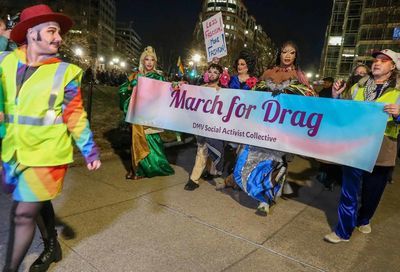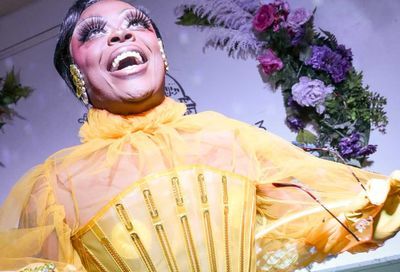Déjà View
When it comes to displays of gay art, things have changed – but a few things remain painfully the same
I was still a fresh-faced newcomer to D.C. 21 years ago when the Robert Mapplethorpe controversy erupted in Congress and the Corcoran museum. The famed gay photographer’s work included both inspired portraiture and beautiful florals, but it was the handful of sexual images — an anally-inserted bullwhip, a tumescent black penis — that inspired fear and loathing among the political class and led the museum to cancel the exhibit.
Actually, had it not been for the controversy I likely would never have seen the exhibit, which went on to be staged at a small downtown gallery where lines of people stretched out the door to see the previously censored photographs. But that small measure of personal good fortune was far outweighed by the chilling effect that settled over the country, not only in terms of federal funding for the arts. The ”no promo homo” policies stretched beyond the National Endowment for the Arts to things such as HIV-prevention programs, where Jesse Helms-inspired homophobia and political opportunism conspired to dull and silence messages intended to save the lives of a generation of gay men.
When I first heard of the Smithsonian National Portrait Gallery’s exhibit, Hide/Seek: Difference and Desire in American Portraiture — the genesis and execution of which is told by Doug Rule in this week’s cover story — I reacted as I expect many gay and lesbian people with memories of the ’90s culture wars would, with a belated sense of ”Finally.”’
Leave it to the right wing to ruin a good thing.
This week news broke that conservative complaints about the exhibit had resulted in the removal of a video component by the late artist David Wojnarowicz. Apparently, while symbolic depictions of crucifixions in everything from Renaissance art to Clint Eastwood films is fair game, when used to illuminate issues of AIDS and suffering the symbolism becomes sacrilegious. Which, as always, says more about the selective understanding of the teachings of Christ by conservative Christians than it does about the art in question.
On cue, congressional Republicans are striking notes of outrage, including Virginia’s tea-party pin-up Rep. Eric Cantor, railing against government funding of gay art — even though funding for Hide/Seek was private. The Smithsonian itself is federally funded as a facility, but attacking on that basis makes about as much sense as calling the federally funded Metro system a tea-party propaganda arm because it happens to take Cantor’s staff to work every day.
But, just as it was back in 1989 when Helms launched his assault, this isn’t about art and it’s not about money. Well, actually, it is about money, just not taxpayer money. It’s about the money that can be raised by inveighing against the gays. It’s about a Republican party that will seize on social issues — gay issues — as Potemkin policies to mask the fact that the party is deeply and gravely unserious about dealing with the nation’s economic problems.
Gay conservatives at GOProud and Log Cabin Republicans have made public calls for their party to keep ”social” issues off the table. Given this art-inspired eruption, along with the party’s recalcitrance on ”Don’t Ask, Don’t Tell” repeal, I don’t expect much to come from those requests.
It’s unlikely that the fight over gay art and lives will be as bruising as we move into 2011 as it was when we began 1990 (though the effect on arts funding will probably be as chilling). The Hide/Seek exhibit is proof in itself that we’ve moved forward — the fight over it is proof we have some distance yet to go.

Support Metro Weekly’s Journalism
These are challenging times for news organizations. And yet it’s crucial we stay active and provide vital resources and information to both our local readers and the world. So won’t you please take a moment and consider supporting Metro Weekly with a membership? For as little as $5 a month, you can help ensure Metro Weekly magazine and MetroWeekly.com remain free, viable resources as we provide the best, most diverse, culturally-resonant LGBTQ coverage in both the D.C. region and around the world. Memberships come with exclusive perks and discounts, your own personal digital delivery of each week’s magazine (and an archive), access to our Member's Lounge when it launches this fall, and exclusive members-only items like Metro Weekly Membership Mugs and Tote Bags! Check out all our membership levels here and please join us today!





















